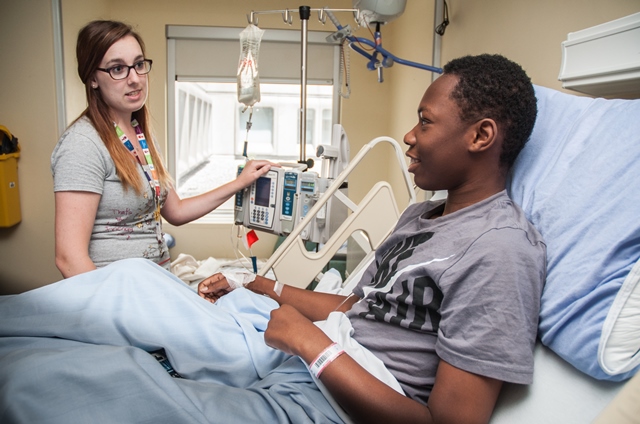
Since he was seven months old, David Lingisi has made regular trips to the hospital – sometimes on a weekly basis. He’s now 17.
At birth, David appeared to be a happy, healthy baby. But within months, his mother knew something was wrong when she couldn’t soothe David from tears with food, sleep or distraction. Blood tests confirmed that David had sickle-cell disease – a disorder that affects hemoglobin, the molecule in red blood cells that delivers oxygen to cells throughout the body. Common symptoms of sickle-cell include repeat infections and episodes of physical pain.
MORE: BREAKING DOWN BARRIERS TO MENTAL HEALTHCARE
David – bright and cheery in his room at Hamilton Health Sciences’ McMaster Children’s Hospital (MCH) site – has required numerous blood transfusions and visits MCH as many as three to four times per month to receive intravenous (IV) infusions of fentanyl, a powerful drug that provides relief to patients who experience high levels of pain.
Due to their powerful nature, drugs like fentanyl require special handling. At MCH, the process for administering such medications has long required patients to receive their treatment in the intensive care unit (ICU) or step-down unit, as a precaution. It meant that even relatively healthy children who weren’t in critical condition had to be admitted to a critical care bed.
Recently, an initiative driven by frontline staff at the hospital has led to the implementation of the Alaris syringe pump, a high-tech drug infusion system that safely and precisely administers potent drugs such as fentanyl and morphine, minimizing the risk of human error and eliminating the need for ICU admission.
“Before this pump, I would have to go to emergency first, then to the ICU or step-down unit,” explains David. “I liked the people there, but I knew that the patients in the rooms beside me were much sicker than I was, and I felt like I was in a bed that someone else needed more than me.”
MORE: TEEN’S WORK TOGETHER TO HELP ENSURE SENIORS’ SAFETY
The move toward the syringe pump was sparked by staff from across MCH who submitted the idea as part of the hospital’s Patient Safety Pledge initiative in fall 2013, where staff members were asked to make suggestions on improving safety in their areas.
Less than one year later, the idea has come to life, thanks to the dedication, hard work and commitment of the MCH Medication Working Group.
The pump is just one example of dozens of safety improvement submissions that are being implemented across McMaster Children’s Hospital. Each will bring the hospital closer to its goal of being the safest children’s hospital in Canada.
“The pump is on my side,” says David. “I’m very grateful for the technology and being able to go straight to the ward and be with some of the nurses that I grew up with. It’s starting to feel like the people here are my family.”

